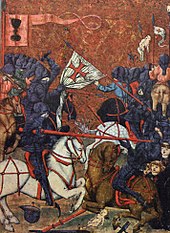Utraquism

Utraquism (from the Latin sub utraque specie, meaning "in both kinds") or Calixtinism (from chalice; Latin: calix, mug, borrowed from Greek kalyx, shell, husk; Czech: kališníci) was the principal dogma, and one of the four articles,[1] of the Calixtines i.e. Hussites, who maintained that both the bread and the wine should be administered to the people during the Eucharist.[2]
History
Utraquism was a Christian dogma first proposed by Jacob of Mies, professor of philosophy at the University of Prague, in 1414.[1] It maintained that the Eucharist should be administered "in both kinds"[2] — as both bread and wine — to all the congregation, including the laity.
The Utraquists were a moderate faction of the Hussites (in contrast to the more radical Taborites, Orebites and Orphans). They were also known as the Prague Party or the Calixtines — from calix, Latin for their emblem, the chalice.[1]
The Utraquists eventually reunited with the Holy See and defeated the more radical Taborites and Orphans at the Battle of Lipany in 1434.[1] After that battle, nearly all forms of Hussite revival were Utraquist, as seen with George of Podebrady, who even managed to cause the city of Tábor, the famous Taborite stronghold, to convert to Utraquism.[citation needed]
Utraquism is routine practice in contemporary Roman Catholicism.
Utraquistic subterfuge
In the book, The Meaning of Meaning, by C.K. Ogden and I.A. Richards, utraquistic subterfuge is described as the use of a term that refers either to its physical, or to its mental referent, and this ambiguity is left open to the interpretation of the individual reader or listener. One example given is the word "perception".[3][4]
See also
References
- ^ a b c d Hughes 1915.
- ^ a b Wood 1907.
- ^ Ogden & Richards 1989, p. [page needed].
- ^ C.K. Ogden and I.A. Richards, The Meaning of Meaning (Mariner Books, 1989) pgs 74, 100, 134.
Bibliography
- Ogden, C. K.; Richards, I. A. (1989) [1923]. "Chapter VI: The Theory of Definitions". The Meaning of Meaning. ISBN 0-15-658446-8.
{{cite book}}: Invalid|ref=harv(help)  This article incorporates text from a publication now in the public domain: Hughes, Joseph (1915). "Utraquism". In Herbermann, Charles (ed.). Catholic Encyclopedia. Vol. 15. New York: Robert Appleton Company.
This article incorporates text from a publication now in the public domain: Hughes, Joseph (1915). "Utraquism". In Herbermann, Charles (ed.). Catholic Encyclopedia. Vol. 15. New York: Robert Appleton Company. This article incorporates text from a publication now in the public domain: Wood, James, ed. (1907). "Utraquists". The Nuttall Encyclopædia. London and New York: Frederick Warne.
This article incorporates text from a publication now in the public domain: Wood, James, ed. (1907). "Utraquists". The Nuttall Encyclopædia. London and New York: Frederick Warne.
